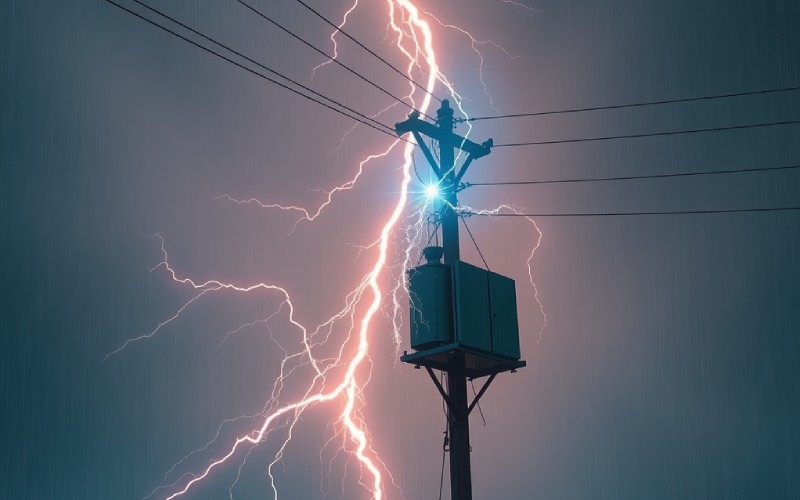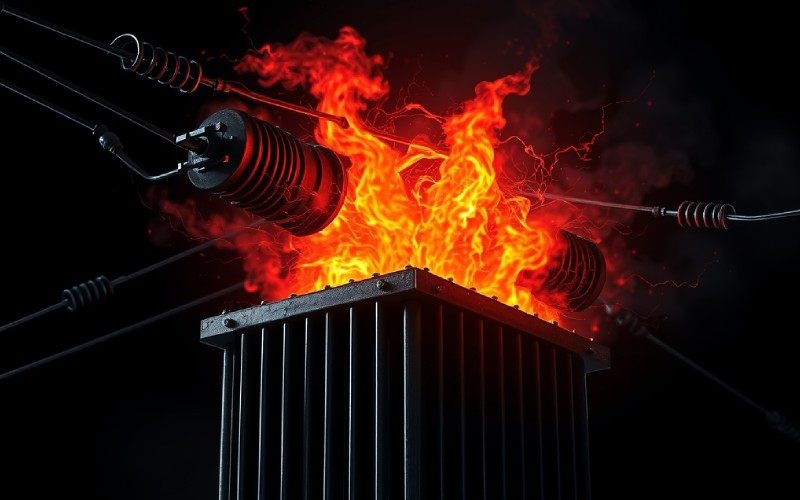Let Sino's Lamination Stacks Empower Your Project!
To speed up your project, you can label Lamination Stacks with details such as tolerance, material, surface finish, whether or not oxidized insulation is required, quantity, and more.

I’ve seen my share of strange things in my career. But few things are as loud or as bright as a transformer explosion. You’ve probably heard one before. A loud bang, then darkness. In this article, I’m going to tell you exactly what happens when a transformer blew. We will look at the causes, the sounds, and the dangers. This is important information to keep you safe during a power outage. Understanding a transformer helps you understand the power that runs your home.
Let me tell you about the metal boxes you see on utility poles. Those are power transformers. A transformer is a device that moves electrical energy from one circuit to another. Its main job is to change the voltage of the electricity. The power grid uses very high voltages to send electricity over long distances. A transformer takes that high voltage and lowers it to a safe level for your home.
These electrical transformers are everywhere. You see them on poles or as big green boxes on the ground in neighborhoods. The power company uses them to manage the flow of electricity. Without a transformer, the high voltage from the power lines would fry every appliance in your house. The transformer is a key part of the modern world. A simple transformer does a very important job for the electrical grid.
The transformer is designed to handle a specific amount of power. Inside the transformer, you have parts like wiring and a special winding. These parts are part of a larger electrical circuit. When everything works right, the transformer quietly does its job. But when something goes wrong, the results can be loud and bright. The transformer is a workhorse of the grid.
The first sign that a transformer blew is often visual. You might see strange flashes of light. This can be a bright flash of white or yellow, or sometimes a weird blue light. This is what happens when a transformer starts to have a serious problem. It’s the electricity arcing where it shouldn’t.
After the light show comes the sound. You will hear a very loud bang. This is the sound of the transformer explosion itself. It’s not a small pop. It is a deep, booming sound that can be catastrophic. Once the transformer explodes, the power in the affected area goes out. This sudden disruption is what starts a local power outage. Your home’s electricity supply is cut off because a key piece of the circuit is broken.
There are several factors that can make a transformer to blow. The most common reason is a simple overload. An overload happens when homes and businesses are pulling too much power through one transformer. The load on the transformer becomes too much for it to handle. This strain can cause the transformer to overheat. The risk of overheating is a serious problem for any transformer.
Another major cause is a short circuit. A short circuit is a low-resistance path in an electrical circuit. This can happen because of failing insulation or old wiring. A short circuit allows a huge amount of current to flow, creating intense heat. This is what often causes a transformer to blow. These events can increase the risk of a complete failure. A damaged transformer may also be a cause. The failure can lead to a transformer blowing.
Yes, absolutely. Bad weather is a top enemy of the power grid. A lightning strike is a very frequent cause of a transformer explosion. Lightning is a massive, uncontrolled discharge of electricity. When it hits or gets near power lines, it sends a sudden surge of power down the wire. This is a huge power surge.
This giant surge of electricity flows directly into the nearest transformer. That transformer is not built to handle such a massive spike in voltage. The lightning instantly destroys the protective insulation inside the transformer, causing a major short circuit. This almost always makes the transformer explode. A single powerful thunderstorm can take out many power transformers and damage the grid. Extreme weather is a big challenge for every utility company.

The sound of a transformer explosion is something you will not forget. People describe it as a loud explosion or a sharp, deafening loud bang. It is not a gentle noise. It’s a deep, powerful boom that can shake your house and rattle windows. The transformer blowing sound like a cannon firing right outside. It is the sound of a rapid and violent failure of a transformer.
Before the big bang, you might hear some warning sounds. A failing transformer can make a buzzing or humming sound that gets louder and louder. This is a sign of stress inside the transformer. A transformer blew in a town, and residents heard this strange buzzing for a minute before the transformer explosion. So, what does a transformer blowing sound like? It sounds like serious trouble for your power.
You bet it is. A blown transformer is a very serious hazard. The force of a transformer explosion can throw hot metal and oil over a wide area. The oil inside many older power transformers is flammable, so when it leaks out, it can easily start a fire. This can lead to serious property damage. It’s a dangerous situation.
The biggest hazard, however, is from electricity itself. The explosion can knock down live power lines. These lines can still have deadly high voltages running through them. There is also the risk of transformer explosions and burns. These explosions and burns often happen to utility workers, but anyone who gets too close is at risk. You should never go near a blown transformer. The hazard is too great. Let the utility company manage the scene. A blown transformer is an emergency.
A power surge is a brief but powerful spike in electrical voltage. I like to explain it as a huge wave of water hitting a small boat. The transformer is the boat. A surge puts far too much stress on all the components inside the transformer. The delicate insulation that protects the winding and other parts can be instantly destroyed by the high voltage levels.
When the insulation fails, it creates a short circuit. The surge also causes the oil and metal in the transformer to overheat in a fraction of a second. This intense heat creates a massive pressure buildup. The transformer may not be able to contain this pressure, and it will explode. A surge is a very fast and destructive event for a transformer. This is why a power surge is so damaging to the electrical grid.

Let’s look at what happens step by step. Inside the transformer, you have coils of wire called a winding. These coils sit in a special mineral oil. This oil provides both insulation and cooling. When a short circuit occurs, an incredible amount of current rushes through the winding. This creates a powerful electrical arc, which is like a small spark of lightning.
That spark is unbelievably hot. It instantly boils the oil around the winding, turning it into a large volume of gas. This gas expands very, very quickly. This creates an enormous pressure buildup inside the sealed tank of the transformer. The tank cannot hold this pressure. This is what causes the transformer explosion. The pressure buildup is too much, and the transformer will explode. This failure is often due to internal damage that happened over time. The transformer may look fine on the outside, but the internal damage is what matters.
Yes, regular maintenance is the best defense. It’s the job of the power company or utility company to inspect their power transformers on a schedule. During these checks, workers look for signs of wear and tear, like oil leaks, rust, or damage to the bushings. They also test the quality of the cooling oil inside the transformer.
Good regular maintenance can find small issues before they become big, dangerous problems. Fixing a small leak or replacing degraded oil can prevent further damage and a potential failure. A well-maintained transformer is much less likely to overheat or develop a short circuit. This protects the entire grid. Technicians also check the transformer fuse, which is designed to break the circuit during an overload and protect the transformer.
If you see or hear a transformer blow and burn, the first and most important thing to do is stay far away. Keep a safe distance of at least 35 feet, or about the length of a school bus. If power lines have fallen, stay even farther away. Never, ever touch a fallen power line or anything it is touching. The situation is a serious hazard, and you must assume every wire is live. This transformer can cause a lot of harm.
Your next step is to call the emergency number for your power company. Do not call 911 unless there is a fire or someone is hurt. Report the transformer explosion and give them your exact location. They will send trained professionals handle the dangerous work of making the affected area safe. They will then begin to repair the circuit and restore power. A transformer can cause a major disruption, but letting the right people know will help them fix the power outage quickly and avoid more trouble.